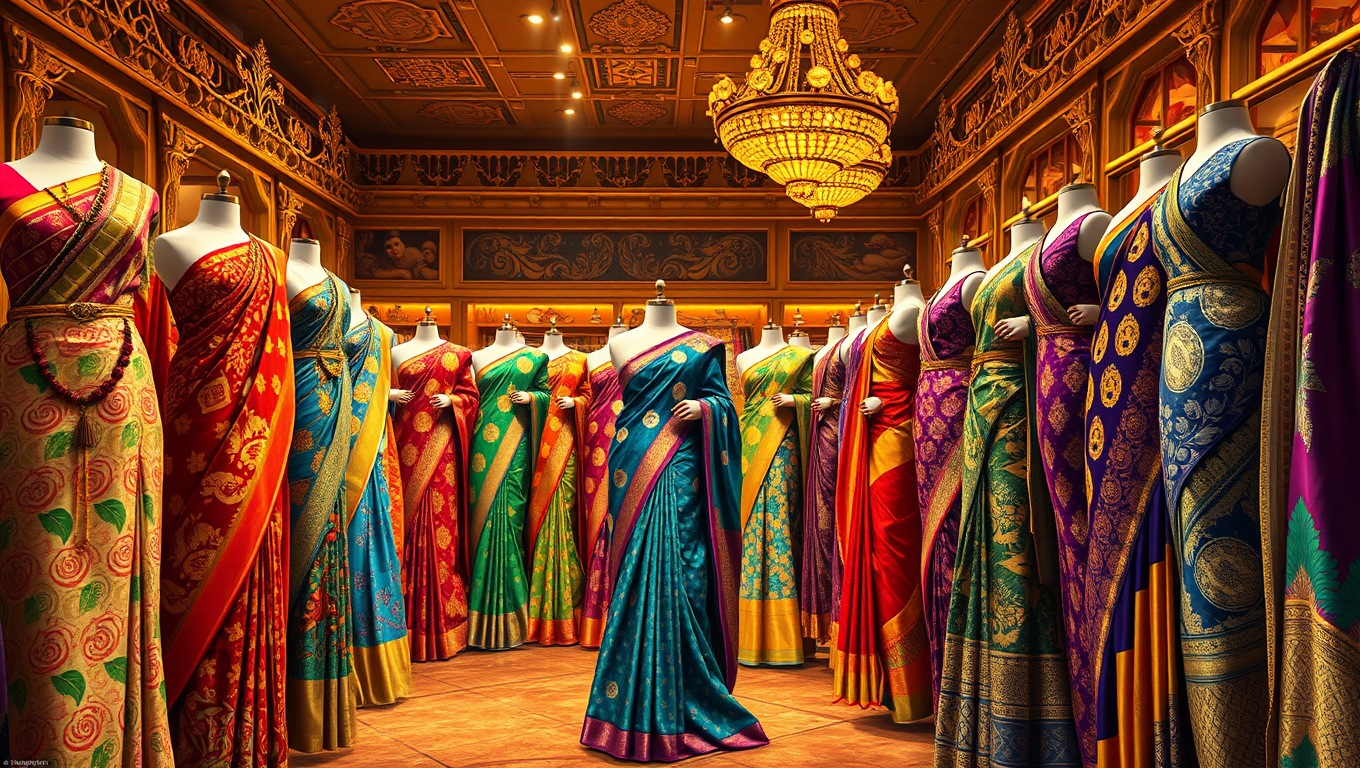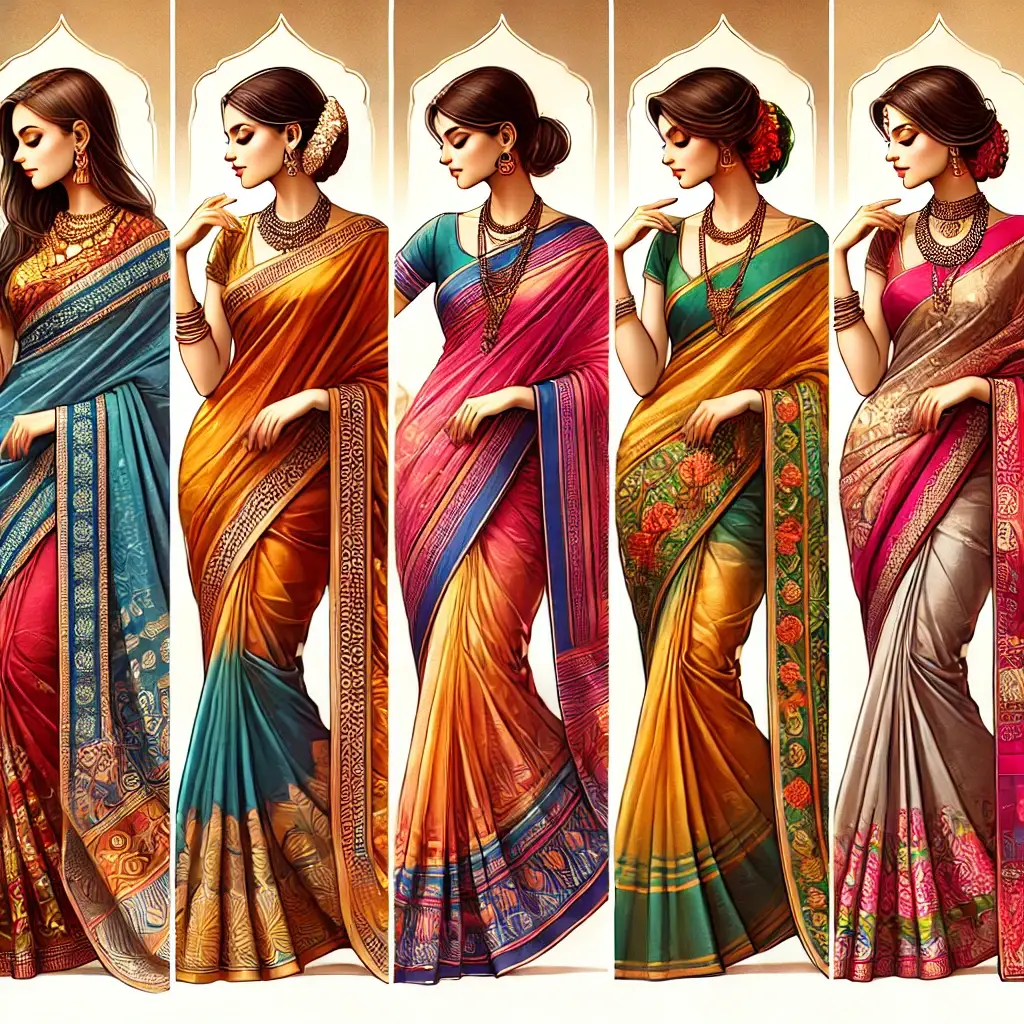
Table of Contents
ToggleSaree Fabrics: An Introduction
There is nothing that can match the grace, grandeur, and versatility of a saree when it comes to traditional Indian wear in the sartorial department. However, did you know that the fabric of your sarees can either make your look or break it? That’s right! The graceful drape of a saree is heavily dependent on the fabric, which is why a good saree fabric is extremely relevant for an ideal outfit. This will help you navigate through the world of saree fabrics with ease After all, you might be a saree enthusiast or a newbie.
Types of Saree Fabrics Explained
So, before we jump directly to the “how” of fabric selection, let’s take a look at some of the most popular saree fabrics. Believe me, each of these will act like a fashion God for you before you even know it!
Silk Sarees – The Queen of Fabrics
Ah, silk! The queen of fabrics. Today you can visit a Silk Saree in showrooms online or in person. They have the facilities for special occasions, when you intend to make heads turn and feel like royalty. But here’s a little secret — silk sarees definitely are not all created equal. From Banarasi to Kanjivaram, there’s an entire universe of silk varieties to discover.
Cotton Sarees – Comfort Meets Elegance
If comfort is your middle name, then cotton sarees are your BFF (Best Friends Forever). They’re breathable, easy to drape and just right for our hot and humid Indian weather. Plus, they are available in an array of absolutely gorgeous prints and weaves, so you are spoiled for choice!
Georgette Sarees – For a Modern Twist
Looking for something that’s easy as pie but still nice enough to serve at the table? Meet georgette sarees! These beauties are characterized by a flowy texture and soft sheen. They work exceptionally well for both formal and semi-formal settings.
Chiffon Sarees – Ethereal Grace
If you want something that shouts romance and femininity, chiffon sarees are the ones to go with. They’re sheer, they’re light, they’re great for those romantic, drapey silhouettes.
Crepe Sarees
Last but not the least, we have crepe sarees. These have a slightly crinkled texture, which gives an interesting dimension to your look. They’re also super low-maintenance – a huge win in my book!
Saree Fabrics: What to Keep in Mind When Choosing
With the basics out of the way, let us dive into how to find the right fabric for you. It’s not just about choosing the most beautiful one (although that is important too!) Here is just a handful of the thing you should have in mind:
Occasion
Are you getting fancy for a wedding or just going out for some casual brunch? When it comes to choosing the appropriate fabric, occasion goes a long way. For instance, you cannot wear a heavy silk saree at a beach party.
Climate and Season
Trust me, you do not want to be wearing a rich Banarasi silk saree in the height of summer. Think about the weather and select fabrics accordingly. Cotton in the summer, silk in the winter – you know the gist!
Body Type
Here’s a thing few people mention — different fabrics suit different body shapes. For example, if you are on the curvier side, structured fabrics like Kanjivaram silk will accentuate your curves perfectly.
Comfort Level
Ultimately, you have to feel good in what you are wearing.” If you are not accustomed to heavy sarees, start with lighter fabrics and build your way up.
Maintenance Needs
No one has ever said we couldn’t be high maintenance, right? If you don’t feel up to regular dry cleaning or careful storage, you may want to limit yourself strictly to easy-care fabrics such as cotton or synthetic blends.
Which Saree Fabric for what purpose?
Now that we have that squared away, let’s get into more detail about what fabrics and patterns are more appropriate for specific occasions. This is where the fun begins!
Wedding And Formal Events
For those large Indian weddings with lots of dancers and performers or formal galas, silk is hard to beat. Banarasi, Kanjivaram or Mysore silk sarees can work wonders in adding that perfect touch of grandeur. If you are looking for something breezier, an embellished georgette or chiffon saree is also a good way to go.
Festive Celebrations
Isn’t it all about colors and happiness during festivals? Choose bright cotton silk or art silk sarees They’re snazzy enough that you can get away with bouncing’ around in all the festivities while looking that good.
Office Wear
For the corporate diva, cotton, linen, crepe sarees are your best bet. They’re business like, uncomplicated and can carry you from boardroom to dinner party with ease.
Casual Outings
Girls’ brunch or a shopping day? That’s where light cotton or linen sarees come to the rescue. They’re easy to throw on, easy to move in and yes, they look effortless and chic.
Saree Fabrics and How to Style Them
Now that you’ve identified your fabric, let’s get into how you wear it. Just remember, the right set of accessories can take your saree game to the next level!
opt for traditional gold jewelry on silk sarees. We’re talking jhumkas, bangles and a statement necklace. Oxidized silver compatible with cotton sarees and even funky, colorful jewelry complement cotton sarees perfectly.
The world is your oyster when it comes to blouses! Try out different necklines and sleeve lengths. A sleeveless blouse would give a more contemporary edge to a traditional silk saree, while a high-neck blouse can elevate even a simple cotton saree to super chic territory.
Don’t forget about the drape! Panes of different fabrics fall differently. Stiffer fabrics, like Kanjivaram silk, are ideal for crisp pleats, while softer fabrics, like chiffon, can be draped in more flowing styles.
How to Maintain Your Saree Fabrics
Finally, we need to discuss the maintenance of your sarees so that you can use them for a long period of time. At each fabric, there are different care specifications, so be sure to pay attention!
Silk sarees need to be dry cleaned and stored in a dry, cool area. Most cotton sarees can be machine-washed, always check the care label first. Hand washing is typically the safest option for more-sensitive fabrics like chiffon and georgette.
Use a soft cloth to wrap your sarees when storing them and avoid hanging your sarees for long. And a tip here – keep some neem leaves in the saree drawer. They are a natural moth deterrent!
Conclusion
It is not daunting to choose the right saree fabric. With this guide at your disposal, you are now prepared to make great fabric decisions for any occasion. Once again, the most important thing is to choose clothing that will allow for comfort, practicality, but also make you look stylish. So, play around, mix and match fabrics and discover a saree that is meant only for you! After all, a perfectly picked saree is more than just an ensemble — it is a statement!
FAQs
1.How to pick the right fabric saree for a summer wedding?
For summer wedding, varieties of silk such as tussar or light weight of Banarasi silk. They are breathable and look great, so Georgette and chiffon are also good options.
2. How to look formal in a cotton saree?
Dim light blue cotton saree with zari work. Balance it out with a frilly top and flashy jewels for a ready-to-wear feel.
3. Is synthetic saree fabrics a good option?
Synthetic fabrics such as polyester can work, too, if you’re on a budget. They require little upkeep and are available in many styles. But they can be less comfortable than natural fabrics when it is hot.
4. How frequently should I dry wash my silk sarees?
Silk sarees should ideally be dry cleaned after every 4-5 wears. But cleaning should be immediate if there are visible stains or odors.
5. Are chiffon sarees suited for a traditional ceremony?
Chiffon sarees are adaptable, but for extremely traditional ceremonies, it’s best to choose classic textures like silk. Semi-formals: A heavily embellished chiffon saree, however, would work for semi-formal traditional events.

